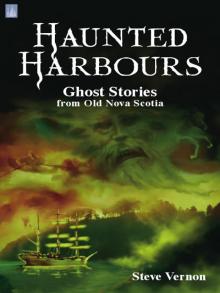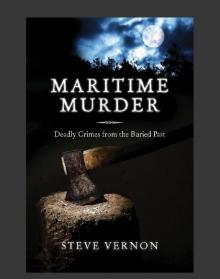- Home
- Steve Vernon
The Lunenburg Werewolf Page 2
The Lunenburg Werewolf Read online
Page 2
“We were attacked by savage Indians,” Susannah went on to explain. “They surprised us at nightfall. They killed the crew and stripped the vessel of everything that could be removed. I managed to survive by locking myself in the captain’s cabin. I fought them off with a pair of flintlock pistols that I found hidden in a sea chest in the cabin.”
Her rescuers were naturally touched by this story of lone heroism, but there were still a lot of nagging questions that badly needed answering: How had this massacre taken place so close to civilization without being noticed? What were the natives, who had absolutely no history of piracy or massacring shipwreck victims, actually doing out there, so far from their home and hunting ground? What had happened to all the bodies? And why hadn’t the attackers, whoever they were, simply broken down the cabin door and overpowered Susannah after her two flintlock pistols were emptied? Unfortunately, Susannah couldn’t offer any answers that even came close to satisfying these questions.
“The Indians stripped the vessel of what valuables they could find and departed,” she explained. “Afterwards I fainted from fatigue and hunger. I knew nothing until you good people rescued me. I’m afraid that I do not know what became of the bodies of the captain, my husband, and the crew.”
She went on to explain that along with seizing the ship’s cargo, which she estimated to be valued at about twelve hundred pounds sterling, the mysterious attackers had robbed her of a personal fortune worth sixteen hundred pounds sterling in silver and gold.
“Besides that,” she went on. “They stripped the ship of its sails, rigging, furniture, armament, and six fully working swivel guns.”
Naturally, the townsfolk did not wish to push a possibly unnecessary interrogation upon the woman. After all, she had barely survived a massacre and had been through a terrifying ordeal. Why punish her further by asking futile questions? She had been through so very much already—hadn’t she?
The Hoodoo Ship
At the time of Susannah’s arrival, Governor Lawrence Armstrong was the official in command of Annapolis Royal. In May 1736, Armstrong heard word of the fate of the crew of the Baltimore and dispatched Ensign Charles Vane with an armed party to apprehend the mysterious woman who had been found aboard the ship. “We will get to the bottom of this,” the governor swore.
Once Vane and the armed party had safely arrested Susannah, they sailed the Baltimore back to Annapolis Royal, where they moored her in the harbour. Susannah Buckler appeared before a council and was questioned at length. She repeated her previous story, almost verbatim.
All winter long, the Baltimore lay anchored in the harbour. People almost forgot that she was there. As time passed, the ship was stripped of anything worth stealing. She grew a bad reputation, and the local folk began to think of the vessel as some sort of jinx. They gave the Baltimore the nickname “The Hoodoo Ship.” Some even called it “The Death Ship.”
After a time, no one would board, purchase, or sail the ship. Finally, Armstrong ordered the Baltimore destroyed. The ill-fated brigantine was towed out to sea, torches were lit and thrown, and the Baltimore burned to the water’s edge and sank.
Unfortunately, the mystery still remained.
Getting to the Bottom of It
Finally, word was received from Ireland regarding the nature of the passengers on the ship, and the story of what really happened was pieced together. It seemed that the woman who called herself “Susannah Buckler” had actually been a convict, one of sixty convicted criminals who were being transported to Annapolis, Maryland, aboard the Baltimore.
During the passage across the Atlantic, “Susannah” had managed to make friends with the ship’s owner, Andrew Buckler. Through Buckler she had become acquainted with the captain of the vessel. Before the ship had reached Nova Scotia, “Susannah” had managed to free her fellow convicts, who’d massacred every member of the crew. Afterwards, they’d flung the crewmen’s bodies into the water to wash ashore at Murder Island. However, their bloodlust had remained unquenched.
An argument amongst the criminals had somehow escalated into a full-blown battle, and the convicts had killed one another off until only “Susannah” and nine other ex-prisoners remained alive. Then “Susannah” had finished the rest of her comrades off with a pot of salt pork stew—carefully seasoned with rat poison—after which she’d heaved the final nine bodies over the side and into the Atlantic Ocean’s cold, merciless grasp.
A perfect crime, or so she’d thought.
Susannah’s Fate
Following her imprisonment, the woman known only as “Susannah Buckler” made friends with one of her guards and eventually escaped from Annapolis Royal. She fled — some believe with the help of the guard and others believe with the help of a fisherman—across the border to Boston, where all trace of her disappeared. Perhaps she died.
Of the booty that was taken from the Baltimore, no trace was ever found. To this day, local fishermen claim to see the spirits of the massacred men walking the shores of Murder Island by moonlight and hear strange moans and groans about the shoreline. Some believe that the restless spirits are guarding a hidden buried treasure, while others believe that these spectres hunger for a revenge for their unjust slaying.
In the year 1803, a ship known as the Favourite sank mysteriously in the heart of Pictou Harbour. Strangely enough, as the story goes, the sad catastrophe began with nothing more than a bad case of indigestion.
The Favourite sailed from the port town of Ullapool, Loch Broom, Scotland, under the command of a Captain Ballantyne. The ship carried a total of five hundred immigrants, all of them eager to find themselves a home in Nova Scotia. The Favourite made the journey in a record five weeks and three days, which was considered by all as a fine omen of good luck to come—which just shows you how much trust you should put in an omen.
A Fatal Stomach Ache
Ian was a sailor—just the same as his father and his father’s father before him. “The men in my family have always worked the sea,” Ian would tell anyone who would listen. “We do things one way and one way only—our way—which is fine enough for me.” So when Ian signed on as a crewman of the Favourite, he was following in the soggy footsteps of his family line and he figured that he could do no wrong.
The Favourite arrived in Pictou Harbour with 500 passengers—plus one more. There had been no deaths during the passage, so the birth of a baby had brought the passenger list to 501.
The ship’s passengers and crew celebrated their landing in fine Highland style. Ian ate a wee bit too much kidney pie, and no matter how much home-brewed dark ale he tried to wash that kidney pie down with, the fire in his aching belly refused to die.
The townsfolk told him to go and see the old woman who lived in a shack just outside of town. “She knows things,” they told Ian. “She will fix you up in no time at all.”
The old woman brewed Ian a potent potion of teaberry, burdock, and sweet honey. Then she placed a cold compress over his head and told him to lie still in the cool shade of her cabin until his stomach ache had passed.
“Leave a coin on the kitchen counter when you leave,” she told him. “Whatever you feel it is worth is worth enough for me.” And then she left to milk the cow.
After a short time, Ian’s indigestion passed, and he removed the cold compress and began to think about all of the fun he was missing in town. He dropped the compress on the counter and forgot to give the old woman her payment. Instead he went down to the town, where he danced the night away.
When the old woman returned and found no coin on the counter, her feelings were hurt. She walked down into town and found Ian in a tavern. When she confronted him and demanded her money, he took offence.
“I feel fine now,” he told her in no uncertain terms. “In fact, it was your stinking tea that gave me the belly ache in the first place.” Which was a bold lie, but Ian had been in that tavern for a little too lon
g and the strong dark ale had run to his head. Being young and foolhardy, he gave the matter no further thought. After all, what did the feelings of one old woman really matter in the long run of things?
Cursed by the Stone
That same night, the old woman went out beneath the full moon to work a little spell of vengeance magic. She decided that it would serve her needs best if she cursed the ship, rather than the sailor. That way he would live and learn his lesson. Or so she hoped.
She walked along the shore of the harbour, staring at the ship that Ian had sailed in on. “I curse you by the stone,” she said aloud. And then she took a stick of charcoal and marked the ship’s name upon the stone. She walked three times in a circle, holding the stone high above her head, letting the moonlight wash over it. Then she spat upon the stone three times. Each time she spat, she whispered a word that should never be spoken lightly, a word that had been spoken to her by a demon in the darkest of hours.
When she was finished, the old woman flung the spat-on stone as high and as far as she could. The stone arced above the water, startling a night bird into panicked flight. For just a moment it looked as if the stone might accidentally strike the moon and knock it from its heavenly perch. Then the stone arced downward, hit the cool Atlantic waters of Pictou Harbour, splashed three times, and sank without a trace.
And that night, while Ian and the rest of the ship’s crew were singing and making merry in the town tavern, the Favourite slid into the waters of Pictou Harbour and sank like a stone.
The next morning, young Ian walked dutifully to the old woman’s shanty and laid a silver coin upon her counter. That very same day, every sailor and officer who served on board the Favourite did likewise.
Folks in Pictou still talk about the ship that was sunk by witchcraft.
The Northumberland Strait is that wide waterway that separates the province of Prince Edward Island from New Brunswick and Nova Scotia, stretching a length of 209 kilometres, with a width spanning from 13 to 48 kilometres. Jacques Cartier originally named the passage the Baie de Lunario because he had entered its northern end on July 1, 1534—the day of St. Lunarius. The famous British surveyor Samuel Holland renamed the strait the Red Sea because the water often shone a brilliant blazing red hue at sunrise. However, after a long and lengthy debate, during which it was pointed out that the watery passage in question was neither a bay nor a sea, the government-appointed Canadian Board on Geographical Names settled on naming the passage the Northumberland Strait, after the HMS Northumberland, the seventy-gun flagship captained by the famed explorer James Cook. However, what makes this stretch of water curious isn’t its name, but the fact that it is home to the best-known and most frequently witnessed ghost ship in all of Nova Scotia—the Phantom Ship of Northumberland Strait.
The Phantom Ship of the Northumberland Strait has been spotted in the Nova Scotia towns of Pictou, Tatamagouche, Wallace, Pugwash, Mulgrave, Inverness, Cheticamp, and Caribou. There are also tales of ship sightings in the Prince Edward Island towns of Alabany, Canoe Cove, Wood Islands, West Point, Murray Harbour, Tignish, Summerside, and Charlottetown. As well, there are stories circulating about sightings in the New Brunswick locales of Richibucto, Buctouche, Shediac, Shippigan, Baie Verte, and Cape Tormentine. The fact is, the Phantom Ship of the Northumberland Strait has been continually spotted and reported along the entire length of the wave-tossed Strait since the late 1700s, when it was first witnessed by wandering Mi’kmaq hunters. And each region and town has its own version of the legend.
Some say that the Phantom Ship is the spectral reappearance of a rich man’s pleasure craft. They talk about how, during a drunken brawl on deck, a lamp was upset and exploded into flames. They describe a ghostly cutlass duel that is forever fought on board the Phantom Ship as the flames climb eternally higher.
Others believe that the Phantom Ship is the incarnation of a Scottish immigrant ship bound for Quebec years ago. The ship was blown off course by a howling storm and struck by lightning. Not a soul survived.
Still others, including Helen Creighton in her classic story collection Bluenose Ghosts, describe the Phantom Ship as a ball of fire—dark red and glowing like a blacksmith’s forge—that slowly takes shape before the onlooker’s eyes and transforms into a three-masted schooner. It often appears in the Northumberland Strait when the wind is blowing from the northeast and is frequently witnessed in the harvest months of September and October.
And even others still, mainly those who live along the New Brunswick coastline facing the Northumberland Strait, refer to the Phantom Ship as the “John Craig Light,” after a ship named the John Craig that was wrecked off of the treacherous, rock-strewn waters of the Shippigan Shoals.
But on Pictou Island in Nova Scotia, fishermen, folklorists, and storytellers have added a completely different element to the mystery: the tale of the Woman in White, who has been seen to walk slowly down to the water to meet the approach of the Phantom Ship of the Northumberland Strait.
The Woman in White
The wind howled like a sky filled with lonely, ravenous wolves. The towering black spruce trees leaned and bent with the relentless winds as the waves slapped and splashed the Pictou Island shoreline.
“It is a wild night,” Bill Culhane said. “A night when stories beg to be told.”
“The wind is doing a fine enough job of stirring up dust,” Perry Clifton said, “without your gum-gas and hot air adding to the brew.”
“It wasn’t blowing on the night when I first saw her,” Bill Culhane went on.
That was how Bill always did it. He’d lay a sentence out there that usually didn’t seem to have much to do with anything we were talking about. And then he’d just let that sentence dangle, like a well-baited fishing hook, waiting for the first nibble.
Little Jimmy snapped at the bait.
“Saw who?” Little Jimmy asked.
“Now you’ve done it,” Perry said.
“It was calm, you understand,” Culhane began. “Calm and eerie. Not a breath stirred in the harbour. The gulls seemed to hover rather than flap. The moon stared down, without a stir of cloud to obscure her glimmer.”
“How quiet was it?” Jimmy asked.
“Don’t encourage him,” Perry moaned, rolling his eyes.
“It was so quiet,” Culhane went on, “that you kind of had the feeling that the universe was holding its breath, just waiting to see what happened next.”
And that’s all he said. Bill Culhane just sat there. Smiling. Waiting.
Little Jimmy was nearly set to burst when Perry finally spoke up. “Well…what happened next?”
“I thought you’d never ask,” Culhane replied.
“Get on with it.”
So he did. “She’d been waiting for him to sail home,” Culhane continued. “Her name was Sheilagh, and she was waiting for young Tommy Hardigan to come back home from the sea.”
“And what was he doing out to sea?” Perry asked.
“He was working the water,” Culhane explained. “A fisherman, like his father and his father’s father before him. Young Sheilagh had sworn that she was going to marry him for certain. ‘Tommy Hardigan,’ Sheilagh exclaimed. ‘If you don’t meet me at the church altar before the year is up, I’ll swim out and get you, come rain or high water.’ Only you’ve got to be careful what you lay a promise to, because on that windless night Sheilagh looked up and saw the Phantom Ship sailing in on the horizon.”
“What did it look like?” Jimmy wanted to know.
“Hush,” Perry said.
“All three of the ship’s masts were blazing,” Culhane said. “And it had skeletons clambering in the rigging, and a set of sails made out of the tanned skins of a hundred dead men—and the wind filling those sails was so cold and lonely that it had to have been blowing from the mouth of hell itself.”
“Was Sheilagh scared?” Jimmy asked.
“Scared? Not scared. Sad, more like it. She knew that seeing the Phantom Ship this way meant that Tommy was never coming home again.”
“So what did she do?”
“She up and walked down to the water, stepped out into the waves, and waded down into the pounding surf, reaching out in front of her like she was yearning for something that had just barely slipped the stretch of her grasp.”
“You’re lying,” Perry said.
“I’m telling a story,” Culhane corrected. And then he went on. “‘Get back here,’ one man called out. ‘You will drown for sure!’ But if Sheilagh heard him she gave no sign. She just stared straight ahead as the waves lapped up to her waistline. Three of the bravest spectators splashed out into the water to save her and nearly drowned as the ocean swallowed them whole. But none of these men was half as brave as Sheilagh’s daddy. He ran out into the water after her and struck out like he was going to swim all the way to New Brunswick. He was bound and determined to rescue his daughter before she was lost for once and all.”
“So what happened?” Jimmy asked. “Did he get her?”
“He did not,” Culhane said. “She simply vanished like she was never there.”
“Didn’t he even get close to her?” Perry asked.
“He did not,” Culhane repeated. “Afterwards he swore that he had just managed to touch a single lock of her hair before she slipped away into the current. He claimed that hair had felt like a cold, lonely breeze, chilling him down to his finger bones.”
Culhane shivered theatrically and Little Jimmy shivered right along with him.

 Flash Virus: Episode One
Flash Virus: Episode One Cat Tales Issue #3
Cat Tales Issue #3 Cat Tales Issue #1
Cat Tales Issue #1 A Fine Sacrifice
A Fine Sacrifice The Lunenburg Werewolf
The Lunenburg Werewolf October Tales: Seven Creepy Stories (Stories to SERIOUSLY Creep You Out Book 1)
October Tales: Seven Creepy Stories (Stories to SERIOUSLY Creep You Out Book 1) Roadside Ghosts: A Collection of Horror and Dark Fantasy (Stories to SERIOUSLY Creep You Out Book 3)
Roadside Ghosts: A Collection of Horror and Dark Fantasy (Stories to SERIOUSLY Creep You Out Book 3) Haunted Harbours
Haunted Harbours Wicked Woods
Wicked Woods Two Fisted Nasty: A Novella and Three Short Stories (Stories to SERIOUSLY Creep You Out Book 2)
Two Fisted Nasty: A Novella and Three Short Stories (Stories to SERIOUSLY Creep You Out Book 2) A Hat Full of Stories: Three Weird West Tales (Stories to SERIOUSLY Creep You Out Book 9)
A Hat Full of Stories: Three Weird West Tales (Stories to SERIOUSLY Creep You Out Book 9) Bad Valentines: three twisted love stories (Stories To SERIOUSLY Creep You Out Book 7)
Bad Valentines: three twisted love stories (Stories To SERIOUSLY Creep You Out Book 7) Do-Overs and Detours - Eighteen Eerie Tales (Stories to SERIOUSLY Creep You Out Book 4)
Do-Overs and Detours - Eighteen Eerie Tales (Stories to SERIOUSLY Creep You Out Book 4) Tales From The Tangled Wood: Six Stories to SERIOUSLY Creep You Out
Tales From The Tangled Wood: Six Stories to SERIOUSLY Creep You Out Sinking Deeper
Sinking Deeper Bad Valentines 2: Six Twisted Love Stories (Stories to SERIOUSLY Creep You Out Book 5)
Bad Valentines 2: Six Twisted Love Stories (Stories to SERIOUSLY Creep You Out Book 5) Big Hairy Deal
Big Hairy Deal Maritime Murder
Maritime Murder Rueful Regret
Rueful Regret